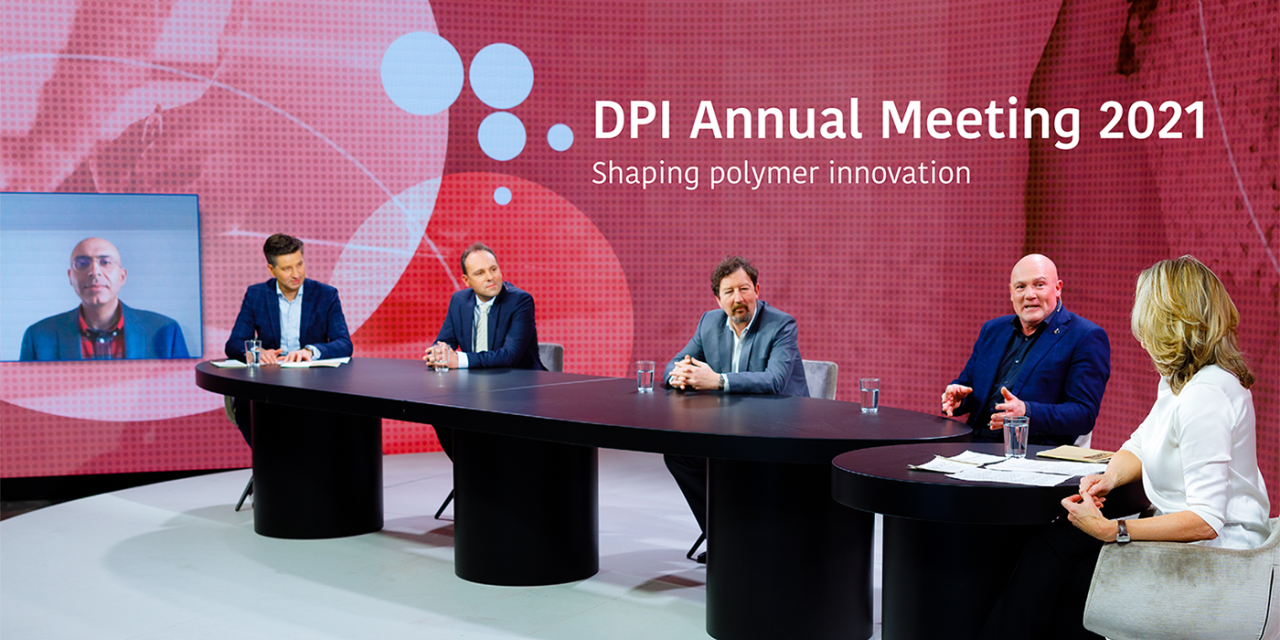Uniting the polymer ecosystem during the DPI Annual Meeting 2021
We all know that the road towards achieving the global sustainability goals can be challenging to navigate. Understanding polymer applications and gaining clear insight into material behaviours are becoming some of the most important focal points in questions of circularity. During DPI’s Annual Meeting 2021, leaders from industry and academia came together to discuss the next steps in polymer expertise and innovation. “You can’t solve these challenges alone. A solid community is the starting point. And an interdisciplinary approach is the way forward.”
The DPI Annual Meeting 2021 took place on Wednesday 17 November and involved conversations with Jerome Claracq, prof. Costantino Creton, prof. Adham Hashibon, dr. André Kuipers, Henk Pool, prof. Bernhard Rieger, Jacqueline Vaessen, Roelof Westerbeek, and DPI Managing Director Ernst Jan van Klinken. The afternoon was moderated by Simone van Trier. Due to COVID-19 regulations the Annual Meeting was held entirely online. Watch the livestream here or scroll down to play the embedded video.
Digital enabling technologies to reach optimal strategies for circularity
The Annual Meeting, which opened with an inspiring keynote speech from ESA astronaut and physician André Kuipers, addressed two main topics: digital enabling technologies for material innovation and polymer excellence, such as artificial intelligence and quantum computing, and strategies for circularity in which industry and science can play a leading role. Two pressing topics that demand attention from everyone in the community and require a new approach.
“The traditional way of doing research is incremental,” Adham Hashibon (University College London) pointed out. “We can reverse this and start by looking at what kind of properties and values our products should have. To do this, however, we need to harvest our entire range of knowledge, for that clever balance between having our circularity goals as a starting point and taking all possible information into consideration. Starting with the target material properties and then adding polymer informatics to the mix means that we can accelerate development and innovation.”
Data-driven material science. Knowing precisely what we bring and return to market
With the growing complexity of the combinations of circularity and performance demands, collaborations between physicists, chemists, and computing experts become increasingly important. As polymer scientists deal with many interconnected variables, quantum computing allows for an insight into all the atomic interactions and molecular structure of the materials from an algorithmic point of view. This means it can be mobilised to create better, more sustainable, and more flexible polymers. “For this, we definitely need creative scientists and industry professionals to think outside of the box,” mentioned Constantino Creton (ESPCI Paris/Scientific Chair DPI). “Now, thanks to digital enabling technologies, we can really take polymer science to the next level. Optimising a material for a particular property can be complicated and relatively costly. But with better data treatment and clever AI applications, organisations enable themselves to do this on a higher pace and innovate faster.”
“Sharing knowledge in the community is key.”
All around us, in every industry, we see that the demand for computing expertise is increasing, and the material and chemical industries are no exception. “The technologies are there, and they are already in use.” Jerome Claracq (Dow Chemical) explained. “We now need to generate atom models that are applicable to our industry. Tomorrow’s science is built on today’s. In collaboration with partners from both industry and science, we develop the necessary algorithms, and within ten years – but hopefully sooner! –, we will truly see that impact of these technologies.”
A fresh look: new strategies allow for new collaborations on an international scale
A critical look into how circularity can be achieved is important, and it needs to be approached holistically. As Henk Pool (Cefic) explained: “‘Is my material circular?’ is not really the right question. People must reflect on something bigger: ‘Will the use of my material be circular and how much of the material will be recycled and brought back into the market?’ The end-of-life strategy needs to be taken into consideration. That is a first metric point.”

Roelof Westerbeek (Highsun Holding Group) concurred: “We have been running the industry by completely different metrics in the past than the ones we need today. It has mostly been about cost and efficiency, which is what the whole industry is tailored to right now. We need to turn around, put the focus on other priorities, and design for recyclability. And in this, we should not wait for legislation; we can teach them.”
“If you want to change perspectives and if you want to push borders you need dreamers, thinkers, technicians, and daredevils.”
“The momentum is changing. That’s for sure,” Jaqueline Vaessen (ChemistryNL) brought to the table. “Between deed and dreams, there are laws and practical objections, as a famous Flemish writer once uttered. We have to make sure that legislation is not going to prevent us from going into the direction we would like to go in.” Of course, there is a great task for regulators to drive circularity, but scientists and industry experts need to be leading the way. The key is that the regulations are harmonised. “And a level playing field is necessary,” Henk Pool added. “We know we will have it in Europe but achieving it on a global scale is incredibly complex. We need to keep focussing on this.”
The right incentives. Taking polymers to the next level for end-to-end circularity
Polymer science is ‘mature’. Consequently, as Bernhard Rieger (TU Munich/Scientific Chair DPI) pointed out, an established, cost-driven industry player, using a product that ‘does the trick’ sufficiently won’t feel a pressing need to change its ways. But it is ever so necessary to have academic scientists connect with those industry experts in their daily work to point out where industry can improve as well: “The entire chain of knowledge needs to be activated, from science to engineering and even all the way down to marketing. For us academics, the industry is our friend. A solid innovation community consisting of both industry and academic experts can take polymer innovation to new heights.”
“It’s not only about the education of young minds. We also have the possibility and the tools to teach politicians.”
The main takeaway? It is all about making those connections of process, manufacturability, and life cycle at the start of a project. A next step would be interoperability and potentially a standardised way of connecting the dots. Ernst Jan van Klinken mentioned: “The key is to focus on polymer circularity, linked to performance materials. We don’t want to waste our time, our students, our expertise, or our money by working on an incoherent case-by-case basis. With our community, we can make polymer innovation and circularity happen on a truly interdisciplinary scale.”
Livestream
Did you miss the livestream on 17 November? The full discussion is now available to watch in the embedded video below.
Please note that this video contains a shortened version of André Kuipers’ presentation instead of the original, full version.
Not able to watch the livestream? Watch the recap of the DPI Annual Meeting 2021!
Questions, remarks, or discussion points?
Get in touch with us. Time to start the conversation.
